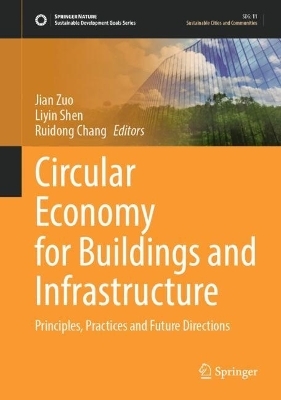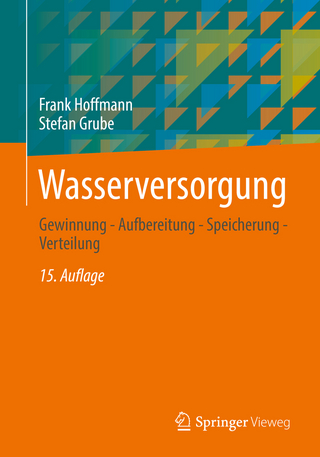
Circular Economy for Buildings and Infrastructure
Springer International Publishing (Verlag)
978-3-031-56240-2 (ISBN)
The building industry has significant environmental, social and economic impacts. As one of the biggest energy consumers and carbon emitters, building sustainability has attracted wide attention globally. Building projects and their associated activities consume a large amount of energy, natural resources and water while producing a large proportion of wastes throughout their lifecycles. The traditional linear approach of "make, use and dispose" has been heavily criticized, whilst the circular approach has gained momentum. Indeed, circular economy has emerged as one of key principles to manage sustainability related issues by means of focusing on the circularity of resources as well as the cost implications.
Dr. Jian Zuo is a Professor in Sustainable Construction at the School of Architecture and Civil Engineering, The University of Adelaide. His main research interests are related to sustainable built environment via both technical (e.g. smart technologies and prefabrication) and managerial (e.g. policy intervention and behavioural change) means. In particular, he has undertaken extensive research in circular economy in built environment such as construction and demolition waste recycling and management. As the lead researcher, he has involved in a series of competitive grants in Australia such as Discovery Projects and Linkage Projects funded by the Australian Research Council as well as many other national key projects. He has long been engaged in the study of ecological towns, green buildings and sustainable development of the construction industry. He has published more than 100 papers in top journals, including more than 80 journal papers indexed by SCI and SSCI, Google Scholar indexed more than 23,000, and the H-index is 83. Professor Zuo serves as editor in a number of top journals such as Journal of Cleaner Production, Ecological Indicators and Journal of Green Building.
Professor Liyin Shen is the Qiantang Distinguished Professor and the Chief Scientist in the Research Institute for Planning and Sustainability in Hangzhou City University. He is also the Director of International Research Centre for Sustainable Built Environment in Chongqing University. Professor Shen has been focusing on research in the discipline of sustainable built environment with specific interests on low carbon city, urban carrying capacity and experience mining for sustainable urban development. He is on the lists of Highly Cited Researcher International published by Clarivate, The Most Cited Chinese Research Scholar published by Elsevier, and The World's Top 2% Scientists (Career & Singleyr) published by Stanford University. Professor Shen was the Founding President of the Chinese Research Institute of Construction Management (CRIOCM) and the Founding Editor-in-Chief for the International Journal of Construction Management (IJCM). He holds a number of external appointments as Honorary Professor and Visiting Professor internationally.
Dr Ruidong Chang joined the University of Adelaide in 2020, after working as a joint research fellow at Solar Energy Research Institute of Singapore, and Department of Building, National University of Singapore, and an assistant professor at Bond University. He has participated in various research projects funded or supported by institutions such as the Building Construction Authority of Singapore, National Science Foundation of China and International Energy Agency. He has published more than 70 journal articles and is an editorial member of Journal of Green Building, and Frontiers in Built Environment. Ruidong Chang conducts interdisciplinary research linking construction engineering, computer science, environmental governance and management science to address grand environmental challenges facing the construction sector. His research focus is 1) at the project level, building a multi-dimensional (Materials-Energy-Emissions nexus) environmental monitoring (what happened) and modelling (what could happen) systems for built environments through advanced data collection and processing techniques such as Building Information Modelling. Based on this foundation, Ruidong then looks at 2) the adoption decision making of environmental-friendly techniques e.g. solar PV and prefabrications in buildings by households, construction firms and the industry, using various management and behaviour theories such as the socio-technical transition theory, innovation diffusion theory and the theory of planned behaviour. All of these areas are examined under the direction of Construction 5.0, namely how to leverage new technologies to enable sustainable construction.Chapter 1 - Introduction.- Chapter 2. Urban waste landscape and inclusive community management: a case study on Hong Kong.- Chapter 3. Inclusive construction management: Insights and recommendations by matching analysis on circular economy (CE) and sustainable development goals (SDGs).- Chapter 4. Carrier-load perspective evaluation on urban resources environment carrying capacity: theory and application.- Chapter 5. Quasi-static and dynamic mechanical properties of recycled aggregate concrete-filled steel tube columns exposed to high temperature.- Chapter 6. Developing an urban resource cadaster for circular economy.- Chapter 7. Modeling Sustainable Housing for Sustainable Development in Cities and Communities: The Perspective of a Developing Economy.- Chapter 8. Low-carbon sustainable development of 5G base stations in China.- Chapter 9. Affordable Housing and Sustainable Communities in sub-Saharan Africa: Implementation Drivers, Challenges and Practices.- Chapter 10. Towards City 5.0: Building Resilient Communities through the Interplay of Circular Economy, Resilient and Sustainable Supply Chains, and Reverse Logistics.- Chapter 11. The impact of transportation and emissions allocation on the global warming potential of concretes containing alternative binders and fillers.- Chapter 12. Costs and Pricing of Green Buildings.- Chapter 13. C&D waste recycling and management: Chinese practices.- Chapter 14. Architects' Behaviour Towards Implementing Construction and Demolition Waste Minimisation Strategies: The Case of Australia.- Chapter 15. Building Occupancy and Smart Metering.- Chapter 16. Building Eco-feedback System and Occupants' Energy Using Behavior.- Chapter 17. Towards the circular economy: improving construction and demolition waste management through stakeholder engagement.- Chapter 18. Circular Economy Outcomes in Civil Infrastructure Projects - A Case Study at the Regency to Pym Street Protect.- Chapter 19. Life cycle assessment of construction and demolition waste: A case study of recycled aggregate products in Australia.- Chapter 20. Towards circularity in roads infrastructure: A critical review.- Chapter 21. Develop a new Revit Plug-in enabling building components-based construction and renovation waste quantification: An Australia study.
| Erscheinungsdatum | 05.05.2024 |
|---|---|
| Reihe/Serie | Sustainable Development Goals Series |
| Zusatzinfo | XV, 344 p. 118 illus., 102 illus. in color. |
| Verlagsort | Cham |
| Sprache | englisch |
| Maße | 178 x 254 mm |
| Themenwelt | Naturwissenschaften ► Biologie ► Ökologie / Naturschutz |
| Technik ► Architektur | |
| Technik ► Elektrotechnik / Energietechnik | |
| Schlagworte | circular economy • housing development • Material Design • smart meters • urban metabolism • waste management |
| ISBN-10 | 3-031-56240-2 / 3031562402 |
| ISBN-13 | 978-3-031-56240-2 / 9783031562402 |
| Zustand | Neuware |
| Haben Sie eine Frage zum Produkt? |
aus dem Bereich


